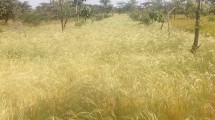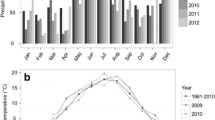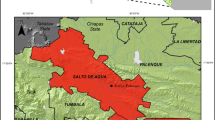Abstract
On-farm experiments were conducted in the Philippines to study over a 4-year period the growth of two timber trees, gmelina (Gmelina arborea R. Br.) and bagras (Eucalyptus deglupta Blume), and their impact on the grain yield of intercropped maize. The experiment consisted of maize monocropping plots (control) and maize intercropped between trees planted in block (2 × 2.5 m), and hedgerow arrangement (1 × 10 m). Three maize crops were planted in the block plots before canopy closure, and seven maize crops were planted in the hedgerow and monocropping plots. Maize grain yield in the hedgerow and in the block arrangement with gmelina were respectively 37% (16.58 tons ha−1) and 68% (8.3 tons ha−1) lower than in monocropping (26.21 tons ha−1). In the plots with bagras, maize grain yield in hedgerow and in block arrangement were respectively 19% (24.8 tons ha−1) and 66% (10.4 tons ha−1) lower than in monocropping (30.6 tons ha−1). For both tree species, the diameter at breast height (dbh) was greater in hedgerow than in block arrangement, with the difference being more pronounced with age. It was estimated that gmelina planted in hedgerows would produce 6–8 m3 ha−1 of merchantable volume more than if planted in block. The study verifies the hypothesis that intercropping between widely-spaced trees rows (planted at 10 m or more) is more profitable and feasible to smallholders than either maize monocropping or woodlots, and concludes with recommendations on how to further improve the productivity of tree-intercropping systems.





Similar content being viewed by others
Notes
This assumption will greatly depend on how profitable the tree-crop association is in comparison to the crop monoculture.
References
Bertomeu M (2004) Smallholder timber production on sloping lands in the Philippines: a systems approach. World Agroforestry Centre. Southeast Asia Regional Research Programme, Los Banos
Bertomeu M (2006) Financial evaluation of smallholder timber-based agroforestry systems in Claveria, Northern Mindanao, the Philippines. Small-Scale For Econ Manage Policy 5(1):57–82
Bertomeu M, Bertomeu M, Fernandez JC (2006) Improving adoptability of farm forestry in the Philippine uplands: a linear programming model. Agrofor Syst 68(1):81–91
Bertomeu M, Roshetko JM, Subekti R (2011) Optimum pruning intensity for reducing crop suppression in a Gmelina–maize smallholder agroforestry system in Claveria, Philippines. Agrofor Syst 83(2):167–180
DENR-ERDB (1998) Development and management of forest plantations: a guidebook. College, Laguna, Philippines: Ecosystems Research and Development Bureau (ERDB)
Francis JK (1988) Eucalyptus deglupta Blume. Kamarere. Department of Agriculture, Forest Service, Southern Forest Experiment Station, New Orleans, p 5
Gaafar AM, Salih AA, Luukkanen O, El Fadl MA, Kaarakka V (2006) Improving the traditional Acacia senegal-crop system in Sudan: the effect of tree density on water use, gum production and crop yields. Agrofor Syst 66(1):1–11
García-Barrios L, Ong CK (2004) Ecological interactions, management lessons and design tools in tropical agroforestry systems. Agrofor Syst 61–62(1–3):221–236
Garrity DP, Agustin PC (1995) Historical land use evolution in a tropical acid upland agroecosystem. Agric Ecosyst Environ 53(1):83–95
Garrity DP, Mercado A (1994) Reforestation through agroforestry: market driven small-holder timber production on the frontier. In: Raintree JB, de Francisco HA (eds) Marketing of Multipurpose Tree Products in Asia. Proceedings of an international workshop held in Baguio City, Philippines, 6–9 December, 1993, Winrock International, Bangkok, pp 265–268
Habiyambere T, Musabimana F (1990) Effect of spacing on the growth and production of Grevillea robusta in the semi-arid region of Bugesera in Rwanda. In: Hardwood CE (ed) Grevillea robusta in agroforestry and forestry. ICRAF, Nairobi, pp 99–102
Hou Q, Brandle J, Hubbard K, Schoeneberger M, Nieto C, Francis Ch (2003) Alteration of soil water content consequent to root-pruning at a windbreak/crop interface in Nebraska, USA. Agrofor Syst 57(2):137–147
Huxley P (1999) Tropical agroforestry. Blackwell Science Ltd., Oxford
Kang BT, Akinnifesi FK, Ladipo DO (1994) Performance of selected woody agroforestry species grown on an alfisol and an ultisol in the humid lowland of West Africa, and their effects on soil properties. J Trop For Sci 7(2):303–312
Kapp GB, Beer J (1995) A comparison of agrisilvicultural systems with plantation forestry in the Atlantic lowlands of Costa Rica. Part I. Tree survival and growth. Agrofor Syst 32(3):207–223
Kenmore ZF, Flinn J C (1987) An ethnohistory of an upland area: Claveria, Misamis Oriental. International Rice Research Institute (IRRI), Manila
Kerr G, Morgan G (2006) Does formative pruning improve the form of broadleaved trees? Can J For Res 36(1):132–141
Kumar BM, Thomas J, Fischer RF (2001) Ailanthus triphysa at different density and fertilizer levels in Kerala, India: tree growth, light transmittance and understorey ginger yield. Agrofor Syst 50(2):133–144
Ladrach WE (2004) Harvesting and comparative thinning alternatives in Gmelina arborea plantations. New For 28(2–3):255–268. doi:10.1023/B:NEFO.0000040952.31476.03
Leroy C, Sabatier S, Wahyuni NS, Barczi JF, Dauzat J, Laurans M, Auclair D (2009) Virtual trees and light capture: a method for optimizing agroforestry stand design. Agrofor Syst 77(1):37–47
Li F, Meng P, Fu D, Wang B (2008) Light distribution, photosynthetic rate and yield in a Paulownia wheat intercropping system in China. Agrofor Syst 74(2):163–172
Magbanua RD, Garrity DP (1988) Acid upland agroecosystems: a microlevel analysis of the Claveria research site. In: Proceedings of the 1988 Acid Upland Research Design Workshop. International Rice Research Institute (IRRI), Los Baños, pp 1–20
Magcale-Macandog DB, Rañola FM, Rañola RF, Ani PAB, Vidal NB (2010) Enhancing the food security of upland farming households through agroforestry in Claveria, Misamis Oriental, Philippines. Agrofor Syst 79(3):327–342
Miah MDG (1993) Performance of selected multipurpose tree species and field crops grown in association as affected by tree branch pruning. PhD dissertation, Central Luzon State University, Muñoz, Nueva Ecija
Midmore DJ, Nissen TM, Poudel DD (2001) Making a living out of agriculture: some reflections on vegetable production systems in the manupali watershed. In: Coxhead I, Buenavista G (eds) Seeking sustainabililty: challenges of agricultural development and environmental management in a Philippine watershed. PCARRD, Los Baños, pp 94–111
Muchiri NM, Pukkala T, Miina J (2002) Optimising the management of maize–Grevillea robusta fields in Kenya. Agrofor Syst 56(1):13–25
Nissen TM, Midmore DJ (2002) Stand basal area as an index of tree competitiveness in timber intercropping. Agrofor Syst 54(1):51–60
Okorio J, Byenkya S, Wajja N, Peden D (1994) Comparative performance of seventeen upperstorey tree species associated with crops in the highlands of Uganda. Agrofor Syst 26(3):185–203
Ong CK, Black CR, Marshall FM, Corlett JE (1996) Principles of resource capture and utilization of light and water. In: Ong CK, Huxley P (eds) Tree-crop interactions: a physiological approach. CAB International, Wallingford, pp 73–158
Palma JHN, Graves AR, Burgess PJ, Keesman KJ, van Keulen H, Mayus M, Reisner Y, Herzog F (2007) Methodological approach for the assessment of environmental effects of agroforestry at the landscape scale. Ecol Eng 29(4):450–462
Peter I, Lehman J (2000) Pruning effects on root distribution and nutrient dynamics in an acacia hedgerow planting in northern Kenya. Agrofor Syst 50(1):59–75
Rao MR, Nair CK, Ong PKR (1997) Biophysical interactions in tropical agroforestry systems. Agrofor Syst 38(1–3):3–50
Reynolds PE, Simpson JA, Thevathasan NV, Gordon AM (2007) Effects of tree competition on corn and soybean photosynthesis, growth, and yield in a temperate tree-based agroforestry intercropping system in southern Ontario, Canada. Ecol Eng 29(4):362–371
Roshetko JM, Mulawarman, Purnomosidhi (2004) Gmelina arborea—a viable species for smallholder tree farming in Indonesia? New Forests 28(2–3):207–215
Santiago RG (1997) Livelihood Enhancement Through Agroforestry (LEAF) Program. In: Developments in Agroforestry Research. ICRAF, FAO-APAN, PCARRD and DOST, Los Baños, Laguna, Philippines, Book Series No. 160/97, pp 45–56
Santos-Martin F, Van Noordwijk M (2009) Trade-offs analysis for possible timber-based agroforestry scenarios using native trees in the Philippines. Agrofor Syst 76(3):555–567
Santos-Martin F, Van Noordwijk M (2011) Is native timber tree intercropping an economically feasible alternative for smallholder farmers in the Philippines? Aust J Agric Resour Econ 55(2):257–272. doi:10.1111/j.1467-8489.2011.00530.x
Schlönvoigt A, Beer J (2001) Initial growth of pioneer timber tree species in a Taungya system in the humid lowlands of Costa Rica. Agrofor Syst 51(2):97–108
Schroth G (1998) A review of belowground interactions in agroforestry, focusing on mechanisms and management options. Agrofor Syst 43(1–3):5–34
Somarriba EJ, Beer JW (1987) Dimensions, volumes and growth of Cordia alliodora in agroforestry systems. Forest Ecol Manage 18(2):113–126
Stamps WT, Mc Graw RL, Godsey L, Woods TL (2009) The ecology and economics of insect pest management in nut tree alley cropping systems in Midwestern United States. Agric Ecosyst Environ 131(1–2):4–8
Stark M (2000) Soil management strategies to sustain continuos crop production between vegetative contour strips on humid tropical hillsides. Technology development and dissemination based on farmers’ adaptive field experimentation in the Philippines. International Centre for Research in Agroforestry. Southeast Asia Regional Research Programme
Thevathasan NV, Gordon AM (2004) Ecology of tree intercropping systems in the North températe región: Experiences from southern Ontario, Canada. Agrofor Syst 61(1–3):257–268
Tomboc CC (1976) Growth, yield and economic rotation of bagras pulp timber in PICOP plantations. MSc Thesis. University of the Philippines, Los Baños, Laguna
Van Noordwijk M, Khasanah N, Hairiah K, Suprayogo D, Macandog D, Lusiana B, Cadisch G (2008a) Agroforestation of grasslands in Southeast Asia: WaNuLCAS model scenarios for shade-based Imperata control during tree establishment. In: Snelder DJ, Lasco RD (eds) Smallholder tree growing for rural development and environmental services. Springer Science + Business Media B. V., Dordrecht, pp 139–159
Van Noordwijk M, Roshetko JM, Murniati, Angeles MD, Suyanto, Fay C, Tomich TP (2008b) Farmer tree planting barriers to sustainable forest management. In: Snelder DJ, Lasco RD (eds) Smallholder tree growing for rural development and environmental services. Springer Science + Business Media B. V., Dordrecht, pp 429–451
Venn TJ, Harrison SR, Herbohn JL (2001) Predicting yields and returns to smallholder plantation forestry: a Philippine case study. In: Harrison SR, Herbohn JL (eds) Sustainable farm forestry in the tropics. Social and economic analysis and policy. Edward Elgar Publishing Ltd., Cheltenham, pp 61–76
Virtucio FD (1984) Determination of taper, bark thickness and volume of commercial tree species. Terminal Report. FORI
Yin R, He Q (1997) The spatial and temporal effects of Paulownia intercropping. The case of northern China. Agrofor Syst 37(1):91–109
Author information
Authors and Affiliations
Corresponding author
Rights and permissions
About this article
Cite this article
Bertomeu, M. Growth and yield of maize and timber trees in smallholder agroforestry systems in Claveria, northern Mindanao, Philippines. Agroforest Syst 84, 73–87 (2012). https://doi.org/10.1007/s10457-011-9444-x
Received:
Accepted:
Published:
Issue Date:
DOI: https://doi.org/10.1007/s10457-011-9444-x




